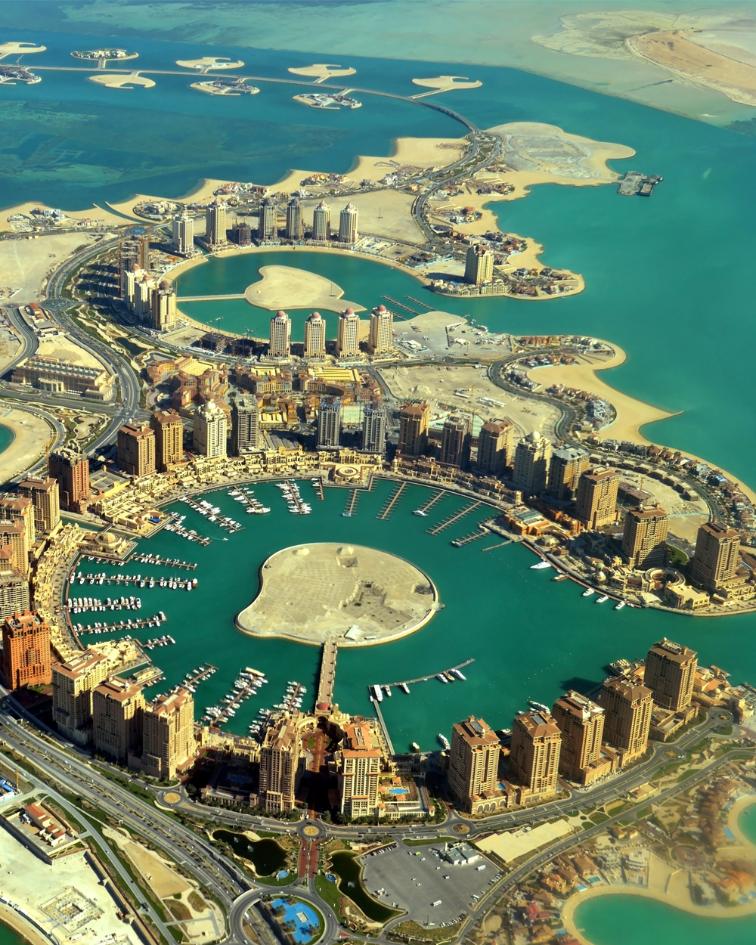Doha is a place of incredible contrasts and history: half bustling cosmopolitan metropolis, half old-school Bedouin charm, it’s home to some of the most high-end shopping malls on the planet and some of the most enchanting old-world traditions.
The Museum of Islamic Art is a magisterial cultural fortress built on its very own island on the Corniche. With three floors of extremely rare Islamic artefacts, there’s plenty to see and the trip is worth it for the building alone (just make sure you cover your shoulders and knees to adhere to the stringent dress code).
Designed by world famous French architect, Jean Nouvel, Doha’s National Museum of Qatar is equally beguiling with a vast array of illuminating historical artefacts and a line-up of art films in the galleries that any film buff will admire. It succeeds in telling the story of the nation and should be booked in advance.
Elsewhere, you can experience the Qatari national sports first-hand: falconry and camel racing. Camel racing takes place on weekends between November and March at the famous Al-Shahaniya racetrack about an hour outside the city. Falcons, some of which can fetch an astonshing £200,000, can be seen at the Falcon Souq in Souq Waqif and, if you ask nicely, you can have your photo done with one of the hooded protagonists perched on your arm.
Oh, and if all else fails, thanks to its tax-free status, there’s some rather nice shopping on offer in Doha's city malls. They're designed as a cool respite to the ceaseless outdoor heat and combine a wealth of retail, eating and entertainment experiences all in mega multiplexes from the future. If retail therapy's what you're after, the Mall of Qatar and Doha Festival City are sure to provide ample comfort.
The second most populous city in the Emirates – and widely considered the cultural capital – Abu Dhabi has a plethora of stuff to educate, entertain and immerse.
A good place to start is at the resting place of Abu Dhabi’s founding father, the late Sheikh Zayed bin Sultan Al Nahyan at the aptly named Sheikh Zayed Grand Mosque. It houses the world’s largest hand-knotted carpet and crystal chandelier, tells the fascinating story of Islam, has a super-unique lighting setup inspired by the lunar cycle of the moon and provides cloaks free of charge on arrival so visitors can respect this profound place of worship.
There’s also a Louvre in Abu Dhabi – the first of its kind outside of Paris – which houses some of the world’s finest artefacts and contemporary art with notable works from Leonardo da Vinci, Pablo Picasso and Ai Weiwei. Hiring a kayak and paddling round its waterside locale at sunset is a popular pastime and a wonderful opportunity to experience the splendour of the gallery’s structure, another Jean Nouvel masterpiece.
Continuing the water-based frolics, it’s also possible for small groups (up to 6) to hire a circular, solar-powered boat to explore the mangroves and spot the native foxes, flamingos, turtles and seasnakes. Rather wonderfully, they’re called Eco-Donut Boats. They need to be booked in advance, you can take some choice nourishments on board and they’re very popular with outdoorsy types at the weekends.
If you’re looking to ramp up the adrenalin, you should also factor in a day at the incomparable Yas Island. Once just a sandy plain, it now boasts a Formula One track, the biggest mall in the Emirates, Warner Bros World, Yas Waterworld, Yas Beach and the fastest roller coaster on the planet at Ferrari World.
Oh, and did we mention the 1,700 animals at Emirates Park Zoo? Or the world’s most Instagrammed hotel? Or how about the unforgettable staycations in the desert? There's much to keep you happy in Abu Dhabi.
And so to the last of three kings of the Middle East at the centre of the Gulf: the bastion of opulence, urbanity, culture and refinement that is Dubai.
First of all, let’s talk about the food. Plentiful work has seen many nationalities flock to the city, with over 200 nationalities represented in its midst. Indians make up the majority and there’s a really vibrant restaurant scene to reflect that. There’s also some really delectable local dishes to be discovered in Bur Dabai: shawarma (delicious lamb or mutton wraps), manakkish (sumptuous dough with cheese or meat topping) and shish tawouk (skewered chicken). It really is mouth-watering stuff.
If you’re an art lover, there’s plenty to make you drool in the Alserkal Art District, too. Abandoned warehouses are choc full of modern Middle Eastern art with eL Seed, Leila Heller and Monir Shahroudy Farmanfarmaiain all on display.
If you don’t spend all your Dirhams there, make sure you tour one of the traditional souks of the area, including the rather descriptive gold souk, spice souk, perfume souk and textile souk. If you see something you like, be sure to haggle. And if haggling is not your thing, there’s plenty more on offer in the rather remarkable Dubai Mall, which doesn’t stop at over 1,200 shops and 120 cafés, it also boasts an Olympic size ice rink and an indoor theme park.
In fact, wherever you go in Dubai, there’s way more on offer than meets the eye, including the nightclubs and bars of Dubai Marina and Jumeirah Beach; the culture and history of the Bastakiya Quarter; the mind-blowing architecture of the DIFC; and the incredible natural wonders of the surroundings areas which can be explored by car or guided tour.
People are flocking to the Dubai in their droves, and it’s very easy to understand why.


